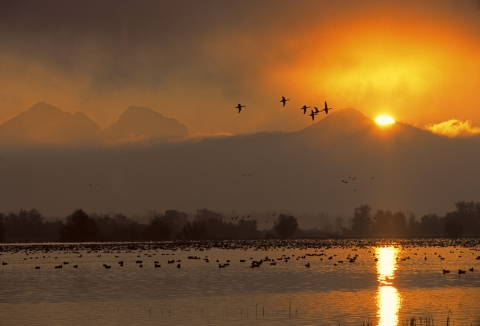Updated November 26, 2025
CURRENTLY OPEN / CLOSED at Sacramento NWR Complex:
- SACRAMENTO NWR:
- Visitor Center and Nature Store = Limited days and hours (please read further down the page under General Information)
- Restrooms (at the Visitor Center & Viewing Platform) = OPEN
- Auto Tour = OPEN
- Trails = OPEN
- Hunt Area = OPEN
- DELEVAN NWR: Hunt Area = OPEN
- COLUSA NWR: Auto Tour, Trail, Restrooms and Hunt Area = OPEN
- SUTTER NWR: Hunt Area = OPEN
- LLANO SECO UNIT: Visitor Area, Restroom and Trail = OPEN
- SACRAMENTO RIVER NWR: OPEN
Visit Us
Welcome to Butte Sink Wildlife Management Area!
Butte Sink WMA primarily consists of properties that are privately-owned and under conservation easement conservation easement
A conservation easement is a voluntary legal agreement between a landowner and a government agency or qualified conservation organization that restricts the type and amount of development that may take place on a property in the future. Conservation easements aim to protect habitat for birds, fish and other wildlife by limiting residential, industrial or commercial development. Contracts may prohibit alteration of the natural topography, conversion of native grassland to cropland, drainage of wetland and establishment of game farms. Easement land remains in private ownership.
Learn more about conservation easement , and therefore DOES NOT HAVE ANY LANDS OPEN TO THE PUBLIC. Although the Butte Sink WMA is not open to the public, you can take a quick virtual tour to learn about what makes it special: Click here to view images, maps, and information about Butte Sink Wildlife Management Area.
There are LOTS of recreational opportunities across the Complex, including a Visitor Center, Auto Tours, trails, bicycling, photography, hunting and environmental education.
VISIT US! <-- CLICK HERE....
to find all the information you need to PLAN YOUR VISIT, like recreational opportunities, what to expect, hours and directions, accessibility, passes and permits, rules and policies, local and contact information. Or jump straight to your favorite activity using these quick links:
VISITOR CENTERAUTO TOURSTRAILSBICYCLINGPHOTOGRAPHYHUNTING-WATERFOWLHunting-RiverMAPS, DIRECTIONS + BROCHURESENVIRONMENTAL EDUCATION
Butte Sink Wildlife Management Area is one of the 5 National Wildlife Refuges and 3 Wildlife Management Areas that make up the Sacramento National Wildlife Refuge Complex:
Location and Contact Information
About Us
The Butte Sink Wildlife Management Area is part of the Sacramento National Wildlife Refuge Complex. It is located west of the Sutter Buttes and east of the Sacramento River in Butte, Colusa, and Sutter counties. It consists primarily of conservation easements on privately-owned wetlands, but also includes on 733 acre fee-title property known as the Butte Sink Unit.
Click on the link below to learn more about us!
What We Do
- Resource Management
To help plants and wildlife, Refuge staff uses a variety of habitat management techniques to maintain, recover or enhance plant and wildlife values. Refuge staff carefully consider any management techniques and employ them in varying degrees according to the situation.
- Conservation and Partnerships
The Complex is involved in many conservation endeavors, including Comprehensive Conservation Plans, Private Landowner Programs, and the National Wildlife Refuge System Improvement Act.
Click on the link below to learn more about what we do!
Our Species
The Butte Sink WMA represents the largest contiguous block of wetlands in the Sacramento Valley and typically supports up to 2 million wintering waterfowl and large numbers of the State-listed as threatened greater sandhill crane. These wetlands also support significant populations of breeding herons, egrets, and other waterbirds.
Click on the link below to learn more about our Seasons of Wildlife, Wildlife Checklist, Wildlife Surveys, and Our Species....



